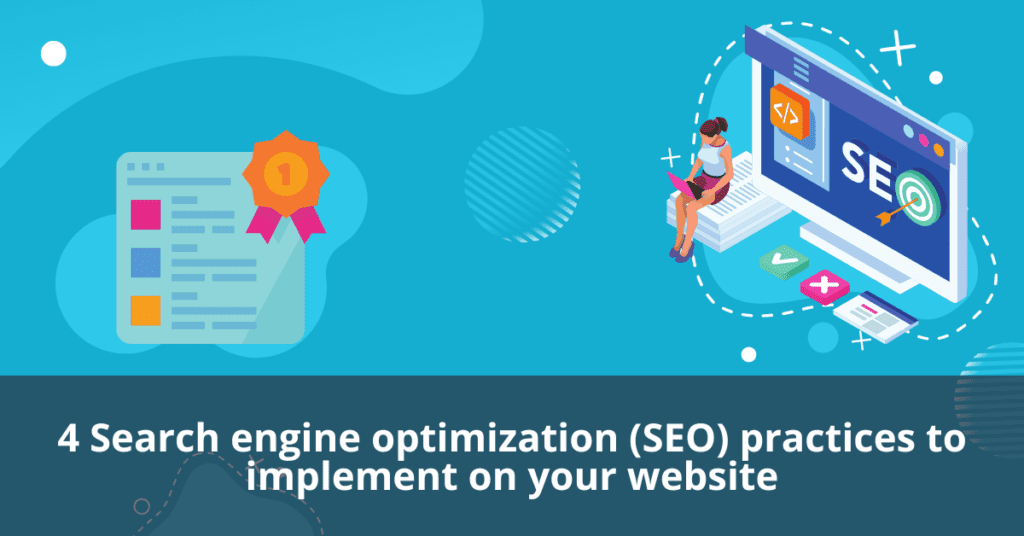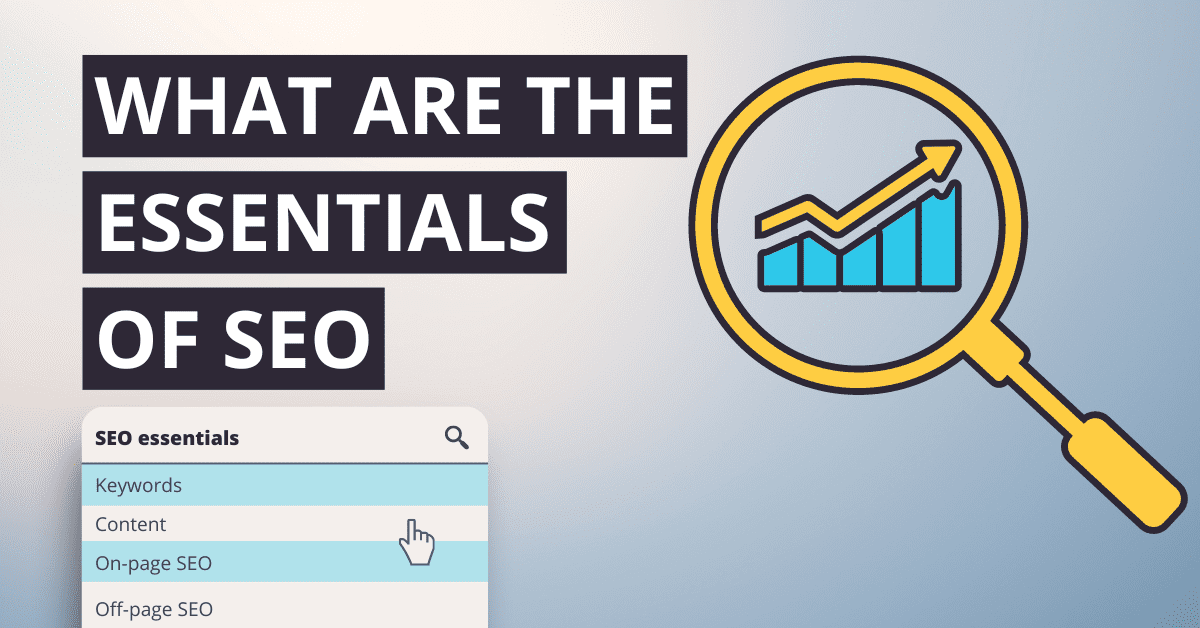4 Search engine optimization (SEO) practices to implement on your website.

If you're looking for an SEO guide to help you boost your site's organic traffic and Google ranking, you've come to the right place. We've put together the ideal practices for driving SEO performance in 2022, which includes the best website principles to be aware of as an online business owner. Use this as a reference point to ensure that your site is sticking to best practices and that you're not being held down by issues that you've overlooked, from SEO basics to must-knows when examining your page signals. Let's start with the question: What is SEO? Search engine optimization, or SEO, is a collection of techniques for improving the appearance and positioning of web pages in organic search results. Because organic search is the most common way for people to find and access online material, an effective SEO plan is critical for increasing the quality and quantity of visitors to your site. Why is SEO so important for your website? SEO is vital since it ensures that the search results are fair. It makes it as hard as possible to manipulate these results, ensuring that the sites that appear for each search are there because they deserved to be there. High search engine rankings are linked to hard work and a website that appeals to users, so if your site satisfies these requirements, you'll have a better chance of appearing in the results. Users trust search engines, and ranking first among search engine results indicates to searchers that your site is a trusted source. The higher you rank on search engine results, the more visitors and clicks your site will get. SEO also enhances the user experience, increasing the chances of repeat purchases. So what are the essentials of SEO marketing?
- Keywords:
Your SEO keywords are the words and phrases in your website content that allow people to find you through search engines. A search engine-optimized website “speaks the same language” as its potential visitor base, with SEO keywords that directly help searchers to your site. Keywords are a critical component of SEO.
In other words, you must understand how people search for the products, services, or information that you provide in order to make it easy for them to find you – otherwise, they will end up on of the many other pages in the google results that shows up in the search. Using keyword SEO is one of the elements that will help your site rank higher than your competitors.
It’s critical to look for keywords with high search rates and how competition, and to incorporate short-tail (such as dog), long-tail (such as terrier puppies for sale), and local (such as puppies for sale in Boston) keywords into your content. A good way to check the keywords volume and low competition is using Google Keyword Planner or Ubersuggest.com, those are tools that will help you find the relevant keywords for your website. - Content:
Content is an essential component of SEO because it is the vehicle through which you reach and engage audiences.
For example, if you owned a hair salon and wanted to boost your visibility, you could write a series of blogs about hair care routines, selecting the right hair products, growing tips, and other topics. When someone searching for hair information on search engines, your blog will appear, and you will be able to build a relationship with that prospect by providing relevant information. The idea is that if that prospect needed to go to a hair salon, for example, you’d be the first person that came to mind.
In general, the various types of content are as follows:- Blog posts: are the most popular format. It could be a mix of text, images, and video. Articles can be news-related, lists, how-to guides, press releases, or general information.
- Static Pages: Content found on your website’s static pages, such as the ‘About Us’ page.
- Product pages: These are pages that promote specific products or services.
- Landing pages: These are pages that are specifically designed to be used in PPC campaigns or as the first page that users see when they visit your website.
- On-page SEO:
On-page SEO (also known as on-site SEO) is the process of optimization on the web pages so that they rank higher in search engines. It includes improvements to the visible content as well as the HTML source code. To accomplish this, you must follow the guidance outlined in this website optimization checklist. There are several points you should check off to rank in search results, varying from optimizing your title tags to using your keywords.- URL:
Use SEO-friendly URLs in addition to logically structuring your URLs. SEO-friendly URLs are simple, easy to read, and include keywords that describe the content on a web page.
If you’re looking for information about dogs, for example, a URL like https://en.wikipedia.org/dogs will help you decide whether or not to click on that link.
A URL like https://www.example.com/index.php!id wca=567&cfor27sap is unfriendly because it does not clearly define what the destination page is really about.
The best user experience is provided by simple URLs. Optimize URLs with explanatory keywords that convey a clear understanding of the page’s content. You should optimize your URLs because it enables search engines give relevant results to searchers and because it lets searchers know exactly what they’ll see if they click the link. - Use Title tag:
Title tags serve as the literal title of a page, informing Google about what to expect on it. Your title is also what appears in search results, and it can influence whether or not a user clicks on your website. Title tags work best when you include an element that naturally draws the attention of users. It appears as the search result’s clickable headline and is important for customer experience, SEO, and social sharing. A web page’s title tag is intended to be an accurate and concise description of the page’s content. - H1:
H1 tags should be used on all important pages on your website to draw the reader in and provide a clear indication of the content on the page. When you have great H1 tags, especially when they match your title tags, it can make a significant difference in your SEO performance.
Technically, an H1 title can be as long as you want because there is no page limit. However, if you’re matching your H1 tag to your title tag (which has limitations on how much of it users will see), you’ll need to pay a little more attention to the length. - Use Meta description:
Meta descriptions are brief summaries of your page that inform visitors about what to expect if they visit your site. In Google search results, meta descriptions appear beneath your title tags. They don’t directly affect your ranking in search results, but they do help persuade Google users to click. - Use Alt tags:
Alt tags are pieces of code that tell Google what an image, video, or audio file is about. Alt tags should be three-to-four-word descriptions of a multimedia element. This allows Google to understand what you’re showing your visitors so that they can judge how good of an experience you provide. It may appear to be a minor detail, but it can easily make or break your search engine ranking when competing with a tough competitor. - Use the HTTPS protocol:
This one appears simple, but according to https://w3techs.com/, only 78.2 percent of all websites in 2022 will redirect to HTTPS.
HTTPS increases the credibility of your website by establishing trust in users—they feel more safe making purchases with their credit card information, address, and phone number. I’m not sure about you, but I never purchase from a site that isn’t secure. If your website is only HTTP, you’re probably going to lose potential customers who are tech-savvy.
- URL:
- Off-page SEO:
Off-page SEO refers to external optimization practices that take place outside of your website rather than on it.
Backlink building is the main technique used for off-page SEO because quality backlinks to your site from external sites tell search engines that your site is valuable and of high quality, which helps to build authority.
Backlink building strategies vary, but some of the current best practices include guest blogging, creating a large number of infographics that will be widely shared, and implementing influencer marketing into your content.
How long does google take to rank your website?
Google can rank your page in a matter of hours, days, weeks, or months. The popularity of the content, technical considerations, crawler, and a variety of other factors all influence how long SEO takes to work. But if you implement all the necessary SEO practices on your website, it will definitely help your business growth in the long run.
0 Comments



